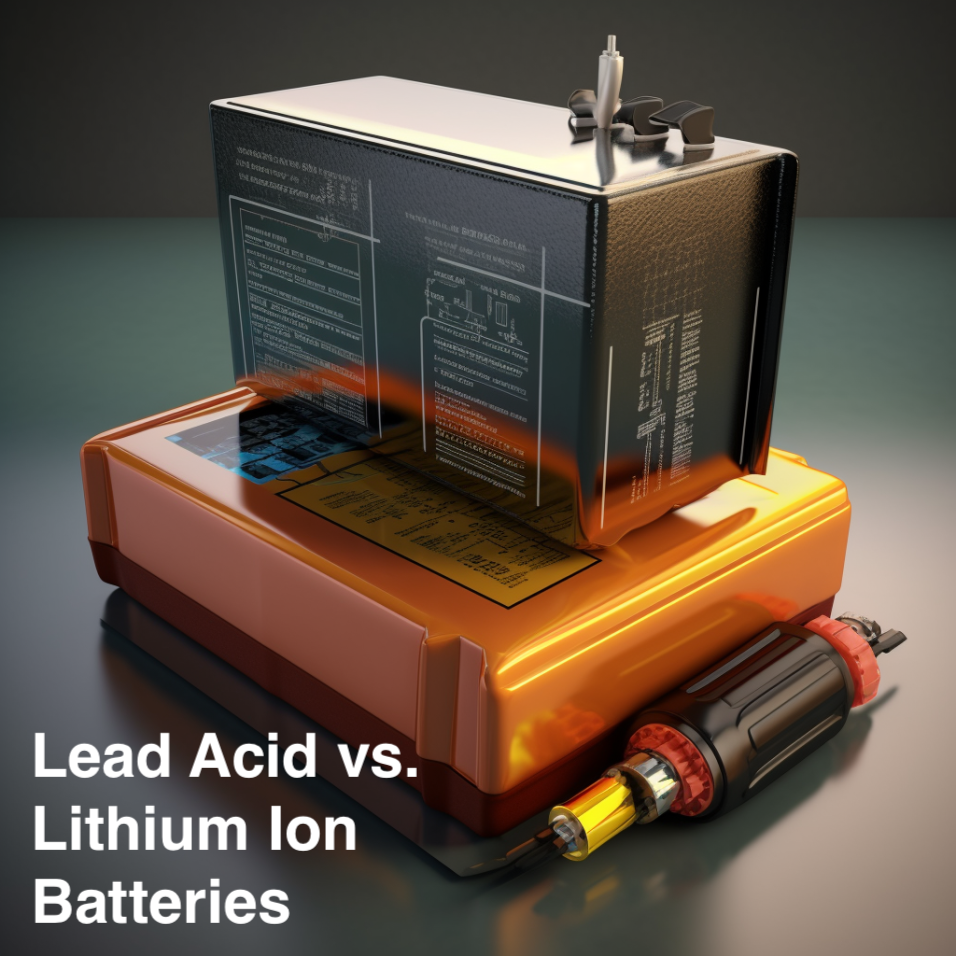
Differences between Lithium-Ion and Lead Acid Batteries
Share
Differences between Lithium-Ion and Lead Acid Batteries
In the world of energy storage, two prominent contenders have emerged as the leading battery technologies: Lithium-ion (Li-ion) batteries and Lead Acid (SLA) batteries. While both serve the purpose of storing and supplying electrical energy, there are substantial differences between them in terms of performance, size, weight, lifespan, charging time, and environmental impact. In this blog post, we will delve into these differences and explore why Lithium-ion batteries are considered superior to their Lead Acid counterparts.
Size and Weight:
One of the most apparent disparities between Lithium-ion and Lead Acid batteries lies in their physical characteristics. Lithium-ion batteries boast a significantly higher energy density, meaning they can store more energy per unit volume or weight. In fact, a typical Lithium-ion battery is only 1/2 the size and 1/4 the weight of an equivalently rated Lead Acid battery. This compactness and reduced weight make Lithium-ion batteries highly desirable for applications where space and weight limitations are critical, such as portable electronics and electric vehicles.

Voltage Fluctuation:
Lithium-ion batteries maintain a stable voltage output, regardless of the power drawn from them and depth of discharge. On the other hand, Lead Acid batteries exhibit voltage fluctuations that are dependent on the output load. This feature makes Lithium-ion batteries more reliable for applications that require a consistent power supply, as they can deliver a steady voltage, contributing to the overall stability and performance of the system they power.

Cycle Life
Cycle life refers to the number of charge and discharge cycles a battery can endure before its capacity significantly diminishes. Lithium-ion batteries typically exhibit a cycle life of 500 to 700 cycles, retaining at least 5% of their initial capacity. In contrast, Lead Acid batteries have a cycle life of 150 to 300 cycles under similar conditions. This means that Lithium-ion batteries can last significantly longer and provide sustained performance over their lifetime, making them a more cost-effective option in the long run. With our patented charging technology these cycles for our products is extended to over 1200 cycles. This materially extends the life and thus value for your

Capacity:
Lithium-ion batteries offer a stable capacity that is minimally affected by the output current. They can deliver close to their rated capacity, even under high load conditions. In contrast, Lead Acid batteries experience a substantial reduction in capacity when subjected to high output currents. The actual capacity delivered may be much smaller than the rated capacity, limiting their usability in applications that require consistent power output.
Depth of Discharge (D.O.D.):
The depth of discharge refers to the percentage of a battery's capacity that can be safely utilized before recharging is required. Lithium-ion batteries can typically discharge up to 99% of their total capacity, allowing for more extensive use before needing to recharge. Lead Acid batteries, however, have a limited depth of discharge of around 50-60%. This discrepancy in D.O.D. further emphasizes the superior energy utilization and longevity of Lithium-ion batteries.

Charging Time:
Lithium-ion batteries have a significant advantage when it comes to charging time. They can be charged to full capacity in approximately 6 hours, whereas Lead Acid batteries typically require 8 to 12 hours for a complete charge. The faster charging capability of Lithium-ion batteries adds to their convenience and suitability for applications that demand quick turnaround times, such as electric vehicles or renewable energy storage systems.

Temperature Stability:
Lithium-ion batteries exhibit outstanding thermal stability, allowing them to operate within a wide temperature range of -20 to +75 degrees Celsius. In contrast, Lead Acid batteries have a more limited operating temperature range of -20 to +55 degrees Celsius. The superior thermal stability of Lithium-ion batteries enables their usage in various environments and applications where temperature fluctuations are common.

Environmental Impact:
From an environmental perspective, Lithium-ion batteries have a distinct advantage over Lead Acid batteries. Lithium-ion batteries conform to the RoHs (Restriction of Hazardous Substances) standard, ensuring they are free from hazardous materials. In contrast, Lead Acid batteries violate the RoHs standard due to the presence of lead and sulfuric acid, both of which are pollutants. Moreover, Lithium-ion batteries are generally considered non-hazardous waste and can be discarded with regular trash, whereas Lead Acid batteries require specialized recycling due to their harmful components. Additionally due to higher number of cycles in Lithium Ion, the net environmental impact is lower.
Conclusion:
This detailed comparison between Lithium-ion and Lead Acid batteries clearly reveals the numerous advantages of Lithium-ion technology. Its high energy density, compact size, low weight, stable voltage output, extended cycle life, minimal capacity loss with high output currents, deep discharge capability, faster charging time, temperature stability, and environmentally friendly nature make Lithium-ion batteries the preferred choice for a wide range of applications. As technology continues to advance, Lithium-ion batteries are poised to revolutionize the energy storage landscape, powering the future of transportation, renewable energy, and beyond.
All Energy Intelligence power backup products are built using Lithium Ion Batteries.
